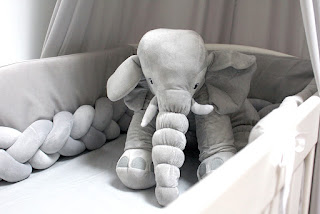Daytime Sleeping Problems
Hannah’s baby girl will be two
months on the 16th October. Her most recent WhatsApp message to me
reads: “The last few days I’ve been a walking zombie since my baby’s sleep
routine is digressing. Sarah is up all day. I’ve tried everything. She naps for
20 minutes, and only when she is on my arm. Today is a good day! She’s been
asleep for about three hours and I’ve taken advantage of this time to get
things done.”
Don’t we all do this? Rush around
like crazy women when baby is sleeping?
I don’t know how long Hannah’s baby
is sleeping at night, but if her daytime routine is changing that allows her to sleep
for longer stretches during the night, that’s a good thing. One reason could be
that her body is establishing a diurnal rhythm – in other words synchronising
her day/night time cycle. We are, after all, a diurnal species – meaning that we’re active during the day and sleep at night. (Some babies take a long
time to learn this!)
The change from sleeping from feed-to-feed
24/7 in the first few weeks of life, to feeding less and sleeping longer during
the night, feeding more often and sleeping less during the day, is a normal
adaptation. It’s influenced by environment, exposure to sunshine (melatonin)
and personality.
Environment:
It’s pretty dark and noisy in the womb where babies first become aware of their
existence. During the first few weeks after birth, the need for food overrides environmental
distractions like light, noise, and discomforts such as a wet or soiled nappy. During
the first six weeks, babies gradually become aware of the difference between
comforts and discomforts. They also learn to communicate how they’re feeling
through body language, facial expressions, grunts, squawks, squeals and crying.
Babies are learning through their senses and after six weeks, become easily
distracted by what they see, hear and perceive with their ‘sixth’ sense – in
other words, they instinctively know when you’re happy, sad or stressed - and behave accordingly!
Melatonin:
This hormone is made during the day and is used the night to induce sleep. The
more sunlight we get, the more melatonin the body can store. Melatonin is also
important for hormonal balancing and regulating immunity. Gradually, Hanna’s
baby will sleep less and less during the day till about the age of four when
she will only need a short nap at midday – usually with other children at
nursery school. Playing in the sunshine build’s melatonin reserves and helps to contributes
to a good night’s sleep.
Personality: Every baby has their own unique personality. While
some need more sleep, others are happy with less. How your baby moved in the
womb can be a hint – was your baby quiet or very busy? Personality is stamped
into our DNA and stretches way back to previous generations. While babies don’t
come with a printout of their personality, needs and preferences, parents quickly
learn this by trial and error.
Top
tips:
Cultural customs: When visiting Malawi, I watched mothers with their
babies. Women carry their babies in a sling called a chitenje. This multi-purpose cloth has many uses. It’s used by mothers
to ‘wear’ their babies either on their back, hip or chest. Tightly coiled, the chitenje cushions the head and helps to relieve the discomfort of
carrying heavy items on their heads – from massive containers of water, to bundles
of wood. Because babies are breast-fed for at least the first two years of
life, they’re literally ‘attached’ to mom for all this time. There’s no
time-keeping. Babies sleep, feed, or watch the world go by whenever it suits
them. Our western life-style is so very different. Women working from home need
to focus on their work, and stick to a strict schedule – which their babies
also learn to do. There’s no harm asking your helper to carry your baby on her
back while she works, learning to do this yourself or teaching your partner
(especially if he is also working from home) to do this from time to time.
Sleep induces sleep: Experience taught me that after a
good night’s sleep, after a quick feed, your baby is ready for another nap –
just for an hour or so. This little sleep helps to set the tone for regular
naps during the day.
Bathing baby also makes them drowsy and ready for a sleep.
Don’t ‘tire’ your baby in the belief that this will induce sleep. Babies
are not programmed like adults. Overstimulating them and tiring them only makes
them ‘overtired’ and cranky.
Stick to routine – but be warned, this changes often
and unexpectedly. No sooner do you get comfortable in one routine when your
baby changes the game, and you find yourself changing gear once more. Be
prepared for this to last for at least two years by which time your baby will
be a toddler – and have you well trained!
Photo: Burgie Ireland – Malawian woman using a chitenje





